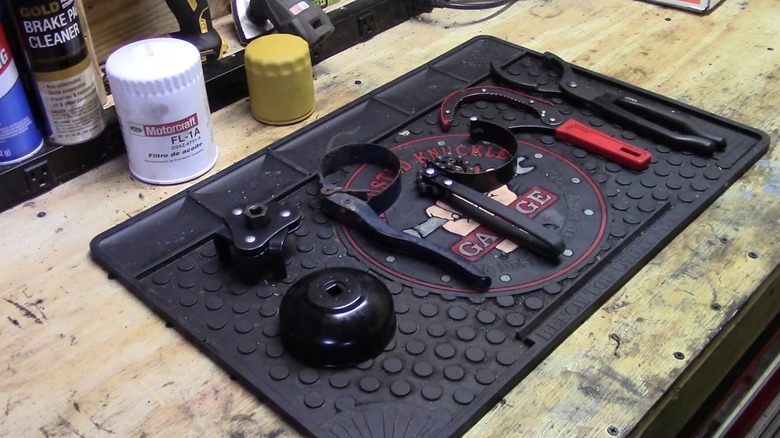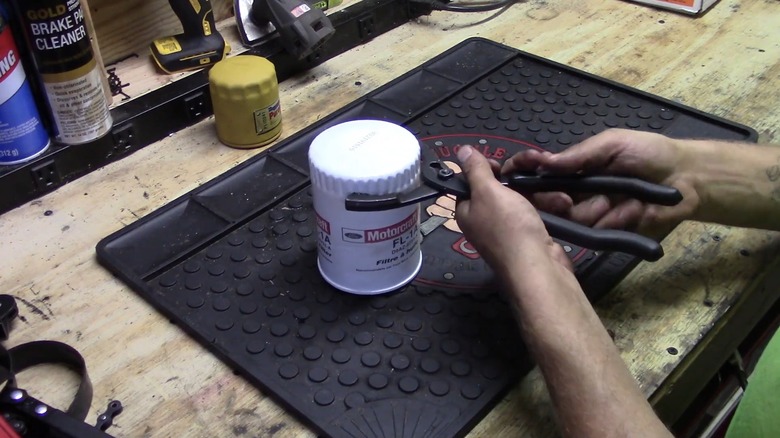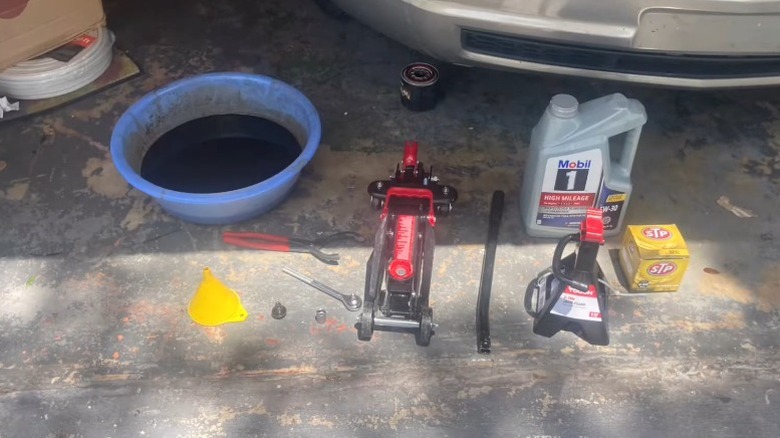How To Tell Which Size Oil Filter Wrench You Need (And How To Use One)
Automotive tools come in various shapes, sizes, and applications. From basic hand tools, like screwdrivers, pliers, and wrenches, to more specialized gadgets like air hammers, OBDII scan tools, and borescopes, mechanics and hardcore gearheads require a lot of tools to tackle many repair and maintenance jobs. Even entry-level DIY auto jobs, like oil and engine air filter replacements, require the use of a handful of tools. One tool, in particular, which can make engine oil changes substantially easier is an oil filter wrench. However, not all automotive oil filters are the same, meaning that not all oil filter wrenches will work for every vehicle.
There are two types of oil filters you're likely to encounter on modern cars: metal screw-on filters and plastic canister filters. Metal oil filters are a single unit that contain a filter inside and attach to the oil filter housing. Canister filters are just an interior filter contained within a plastic canister. To replace a canister filter, you must open the plastic housing, remove the old filter and replace it, and then screw the plastic cap back into place.
Typically, these two types of oil filters require the use of different oil filter wrenches or caps. To determine which type of wrench you need, check your vehicle to see whether it has a metal oil filter or a plastic canister. You can also read your vehicle owner's manual for more information regarding oil replacements and filters. If you're wondering how to use an oil filter wrench, we've got you covered. Here's a more in-depth explanation of oil filter wrenches and how to use them.
How to use an oil filter wrench
Most standard oil filter wrenches and pliers provide a near-universal fit for metal oil filters. As mentioned, metal oil filters are one solid unit that screws into an oil filter housing, usually near the oil pan, although some cars have their oil filters in the engine bay. These types of filters come in various sizes. However, most basic oil filter wrenches and pliers are adjustable, allowing you to grasp filters of numerous different sizes with one device.
To use a regular oil filter wrench or pliers, you simply need to grasp the filter with the tool and turn it to the left to loosen it. Oil filter pliers are the easiest to use and work like you'd expect large pliers to function. Oil filter wrenches that use straps or chains are slightly more complicated and require you to wrap the strap around the filter. These tools are ideal for metal oil filters. However, when metal oil filters are installed properly, you generally won't need a tool to remove them.
Canister filters, on the other hand, typically require the use of a special type of oil filter wrench or adaptor. These wrenches look like small cups or caps which fit over the canister filter and, usually, lock into place. Then, you can attach a ratchet to the wrench and remove the filter. This style of oil filter wrench usually comes in a set of different-sized adaptors, or you can buy an OEM adaptor directly from your dealership. Regardless of whether your car uses canister or metal oil filters, you should only have to use an oil filter wrench to start the removal process. Then, simply unscrew the filter by hand and allow any oil to drain into a container for disposal and recycling.
What other tools are necessary when changing the oil?
In addition to an oil filter wrench, you're likely to need various other tools if you attempt a DIY engine oil replacement. That's because the oil filter isn't the only component that you'll have to remove as part of the process, and these parts are installed far too tightly for the average person to remove by hand.
The most basic tools you'll need to complete an oil change include a ratchet and socket set, the aforementioned oil filter wrench, a container to catch the old oil, a funnel, a torque wrench, an automotive jack, and some cleaning supplies. You'll need the ratchet and socket set to remove at least the oil drain plug, and, depending on your car, you may also need to remove things like skid plates or undercarriage covers to access the oil drain pan. You can substitute a set of wrenches for a ratchet and socket set. However, a quality ratchet and some sockets will make the process easier.
A container is necessary to collect the old oil because you can't just let it drain into the dirt or your driveway, while a torque wrench is essential for reinstalling the drain plug to the correct torque or tightness rating. Also, some type of automotive jack will be necessary to lift the vehicle high enough to give you access to the drain pan, unless you drive a tall truck with enough ground clearance for you to slide underneath, while a funnel is handy for adding fresh oil to the engine. Finally, you'll need some cleaning supplies, like rags and maybe some brake cleaner, to take care of any spills or messes you make during the process.


